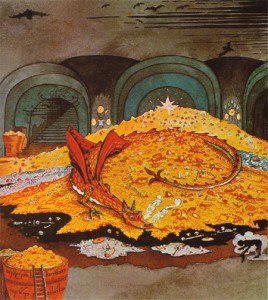 Lauren Davis from SF webzine io9 explores why, “in a media landscape overstuffed with dragons, do we still care so much about Smaug?”.
Lauren Davis from SF webzine io9 explores why, “in a media landscape overstuffed with dragons, do we still care so much about Smaug?”.
This was first published last month, and I missed it at the time, but it’s a very worthwhile read that delves into (among other things) the literary origins of Tolkien’s dragons — the story of Fafnir, and, of course, Beowulf. Follow the link at the bottom to read the complete article.
Why Smaug still matters
“A dragon is no idle fancy,” J.R.R. Tolkien wrote in his lecture “Beowulf: The Monsters and the Critics.” Whatever may be his origins, in fact or invention, the dragon in legend is a potent creation of men’s imagination, richer in significance than his barrow is in gold.”
The dragon Smaug remains one of Tolkien’s most enduring inventions, a standout amongst an increasingly crowded field of dragon characters. And he endures not merely for being the dragon upon whom so many fictional dragons have been based, but also because he represents Tolkien’s care and attention to the idea of dragons and how a well developed dragon character could interact with his Hobbit hero. It’s an attention that ensured Smaug would be captivating not simply as a dragon, but as an interesting and fearsome antagonist.
The origins of Smaug
Tolkien had a lifelong fascination with dragons, and by his own reports was writing stories about them from an early age. In a letter to W.H. Auden (Letter 211), Tolkien refers to a story he wrote about a “green great dragon” when he was seven years old. Although the point of this reference is to highlight his mother’s admonition that he should say “great green dragon” (and Tolkien’s fledgling thoughts on language), it marks an early venture into fantasy.
Smaug was by no means the first dragon by pour from Tolkien’s adult pen, nor even the first dragon he placed in Middle Earth. But Smaug embodies much of Tolkien’s thinking on dragons as literary figures, even if he appears in the pages of one of Tolkien’s more juvenile-targeted stories.
In his lecture “On Fairy Stories,” which Tolkien delivered at the University of St Andrews in 1939 (after the publication of The Hobbit), Tolkien explains that, in imagining dragons, the world seems to be a richer place:
I never imagined that the dragon was of the same order as the horse. And that was not solely because I saw horses daily, but never even the footprint of a worm. The dragon had the trade-mark Of Fairie written upon him. In whatever world he had his being it was an Other-world. Fantasy, the making or glimpsing of Other-worlds, was a profound desire. I desired dragons with a profound desire. Of course, I in my timid body did not wish to have them in the neighborhood, intruding into my relatively safe world, in which it was, for instance, possible to read stories in peace of mind, free from fear. But the world that contained even the imagination of Fáfnir was richer and more beautiful, at whatever cost of peril.


